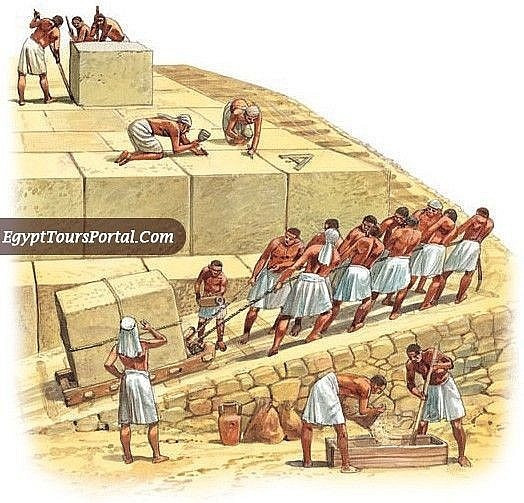The Physics Behind the Construction
Physicists at the University of Amsterdam conducted research on the forces required to pull heavy weights on a giant sled across the desert, and they discovered that wetting the sand in front of the pulling device reduced friction on the sled, making it easier to operate.

Who Built the Egyptian Pyramids?
The pyramids of Egypt are an ancient archaeological wonder, towering over the sandy desert and visible for miles. The construction of these pyramids was undoubtedly a monumental task, so who was responsible for carrying it out?
There are various theories about the builders of the Egyptian pyramids, including large teams of enslaved Hebrews and daring ideas such as the lost city of Atlantis inhabitants or even extraterrestrial beings.
However, none of these theories have any specific evidence to support them.
The pyramids could not have been built by Hebrew slaves, as no archaeological evidence directly links the Hebrews to Egypt during the time of the construction of the Giza pyramids, which dates back 4,500 years.
Furthermore, the story told in the Hebrew Bible about the Hebrews being enslaved in Egypt mentions a city called “Ramesses.” A city named Pi-Ramesses was established during the 19th dynasty (around 1295-1186 BCE) and was named after Ramesses II, who reigned from 1279-1213 BCE. This city was built after the period of pyramid construction in Egypt.

How many stones are needed to build the Egyptian pyramids?
It is estimated that around 2.3 million limestone blocks were used to construct the Great Pyramid of Egypt, which stands nearly 140 meters tall. The largest blocks among these weighed between 25 and 80 tons.
How were the pyramids built?
The techniques used in the construction of the Egyptian pyramids have puzzled historians and scientists for many years. Various controversial theories have been proposed regarding the construction methods. The prevailing theory is based on the belief that the gigantic stone blocks were carved from quarries using copper chisels.
Subsequently, these blocks were dragged and lifted into position. However, the methods related to the movement and placement of these stones are still fiercely debated. The labor force involved in building the pyramids also remains unresolved.
It is believed that the pyramids were constructed using slave labor, while another hypothesis suggests that the pyramids were built by tens of thousands of skilled workers who were employed as free labor with wages.
What is certain is that the labor force was tightly organized and managed at the highest level by adhering to an organized and planned process consisting of three stages.

How many stages are there in the construction of the pyramids?
The labor force followed a specific process to construct the pyramids flawlessly, consisting of three crucial steps: selecting the perfect construction site, preparing the foundation, and raising the blocks.
Stage 1: Selecting the perfect construction site
The first step in building a pyramid was selecting a suitable location. It had to be on the western side of the Nile River, where the sun sets, as the ancient Egyptians believed that wherever the sun set was a gateway to the afterlife.
The pyramids also needed to be placed on elevated land, away from the risk of flooding during the Nile River’s inundation. However, it couldn’t be too far from the Nile River as the river would be used to transport high-quality limestone blocks for the outer casing from Tura across the Nile River.
The chosen location would be a point on the desert plateau, where there is a solid bedrock capable of supporting the immense weight of the pyramid’s blocks without any risk of cracking because the stones are very heavy.
Stage 2: Preparing the foundation
No construction plans for the pyramids have been found, but the construction had to be carried out based on highly accurate measurement methods.
First, the workers had to prepare a solid foundation, and the bedrock had to be made perfectly flat.
Stage 3: Raising the blocks
It is possible that the rooms and corridors inside were built first and then enclosed. The pyramids were constructed using limestone cut from the plateau, with the outer layer of the pyramid built from smoothed limestone blocks cut from Tura.
The stones used for the pyramids would have varied in size, with the largest ones used for constructing the chambers for the Pharaoh. These special blocks differed from the regular limestone blocks and were instead made of granite.
How did the ancient Egyptians move tons of stone to build the pyramids?
To unravel this mystery, researchers from the University of Amsterdam gathered clues from the ancient Egyptians themselves. A wall painting discovered in the ancient tomb of Djehutihotep, dating back to around 1900 BCE, depicts 172 men pulling a giant statue using ropes attached to a sled.

Discovery from the tomb
Lead researcher Daniel Bonn, a physics professor at the University of Amsterdam, noted that the painting shows a person standing in front of the sled, pouring water onto the sand.
Bonn told Live Science, “Egyptologists thought it was a purely ceremonial act. The question is, why did they do it?”
Experimental findings
Bonn and his colleagues constructed miniature sleds and conducted experiments to pull heavy objects across a tray of sand.
When the researchers pulled the sled on dry sand, they observed that the sand would accumulate in front of the sled, requiring more force to pull it through.
However, when water was added to the sand, it increased its stiffness, allowing the sled to glide more easily on the surface. This was due to the water droplets binding the sand particles together, making it easier to pull the sled on wet sand.
However, the moisture level of the sand also had to be appropriate. If it was too dry or too wet, it would be difficult to pull the sled. The necessary amount of water depended on the type of sand, but typically the optimal water content ranged from 2% to 5% of the sand’s volume.
Bonn explained, “It turns out that wetting Egyptian desert sand can reduce friction by quite a bit, which means you need only half the number of people to pull a sled on wet sand compared to dry sand.”